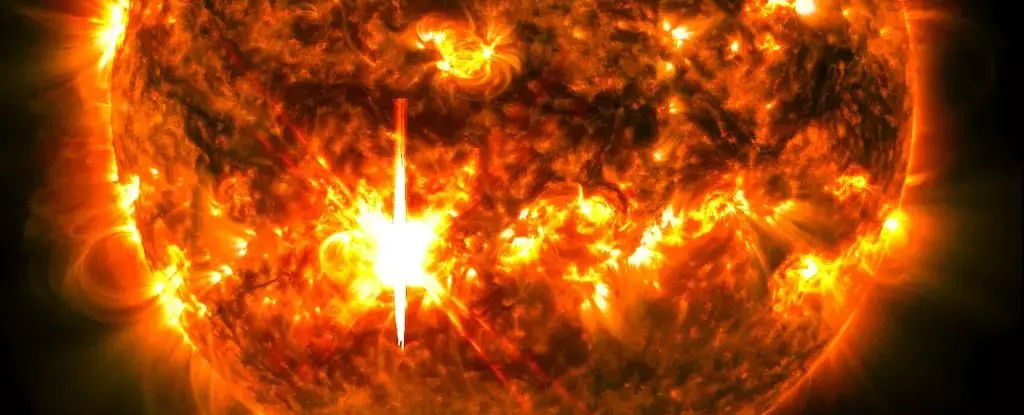October has made its entrance with an electrifying celestial event, thanks to our Sun, which emitted an intense solar flare and coronal mass ejection (CME) on October 1. Touted as an X7.1 flare, this massive eruption ranks as the second most powerful of the current solar cycle and is among the top 30 solar flares recorded in the past three decades. Fortunately, while this solar phenomenon is awe-inspiring, it poses no immediate threat to life on Earth. However, the predictions from the National Oceanic and Atmospheric Administration’s (NOAA) Space Weather Prediction Center suggest that we might soon experience geomagnetic storms of varying intensity from October 3 to October 5.
Solar flares and CMEs are not anomalous events; rather, they are characteristic of the Sun’s behavior, especially as it approaches the peak of its 11-year activity cycle. These occurrences typically arise from sunspot regions where the solar magnetic field exhibits heightened intensity. Sunspots are essentially magnetic anomalies in the Sun’s surface where magnetic field lines intersect and otherwise behave differently from the surrounding area. When opposite magnetic fields become entangled, they can snap and release tremendous energy, resulting in a solar flare—a sudden burst of light.
On the other hand, a coronal mass ejection is a colossal expulsion of solar plasma, which includes billions of tons of charged particles and magnetic fields. When these solar particles reach Earth’s magnetosphere, they can trigger geomagnetic storms, which primarily affect the upper atmosphere but can have broader implications, including disrupting satellite communications and electrical grids.
The recent X7.1 flare originated from a complex sunspot region known as AR 3842. This particular region is designated as a Beta-Gamma-Delta type, which indicates a significantly complicated magnetic environment conducive to explosive activity. With multiple sunspots exhibiting this chaotic arrangement, AR 3842 has been in a prime position for Earth-directed solar eruptions. Just hours after the X-class event, it unleashed an M3.3 flare, further verifying its continuing intensity.
Events at this magnitude can potentially induce disturbances in the Earth’s atmosphere, especially on the sunlit side, where high-frequency radio blackouts may occur. The impacts of CMEs are generally more variable; thus far, it seems that the CME from AR 3842 is not expected to have catastrophic effects, alleviating concerns although it remains a point of interest for scientists.
Solar phenomena of this magnitude often set the stage for remarkable natural displays—most notably, the auroras borealis and australis. When solar particles collide with Earth’s atmosphere, they ionize the gases present, producing the mesmerizing light displays known as the Northern and Southern Lights. The NOAA and other meteorological institutions have forecasted G3-level geomagnetic storms over the nights of October 4 and 5, suggesting that auroras will likely captivate onlookers in higher latitudes.
The Kp Index, which measures geomagnetic activity on a scale of 0 to 9, is projected to reach levels above 6 and 7 on these nights, indicating a high probability of auroras visible in regions typically unaccustomed to such spectacles. Drawing from the experiences of previous solar cycles, we can anticipate that the intensity and frequency of auroras may be unparalleled, especially considering that this year has already been favorable for aurora sightings.
The current activity surrounding AR 3842 serves as a reminder of the Sun’s dynamic nature and its potential effects on our technological systems. Solar flares and CMEs can impact radio signals, GPS accuracy, and power utility functionalities, exemplifying the delicate relationship between our technology-dependent lives and the cosmic phenomena that govern them. Thus, as we look forward to dramatic auroras lighting up the night skies, it’s worthy to remember the interconnectedness of our planet and the solar activity that not only fascinates but also requires our respect and understanding.
Ultimately, the cosmic events of early October remind us of the magnificence of our solar system. As we brace for geomagnetic storms and potential auroral displays in the coming days, we are offered another glimpse of nature’s incredible splendor—a veritable light show in response to the solar ballet occurring millions of miles away. The year has already been generous in auroral presentations; let us hope that the coming days will further enrich our celestial experiences. Keeping an eye on the skies has never been more exciting!


Leave a Reply